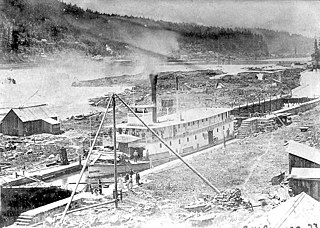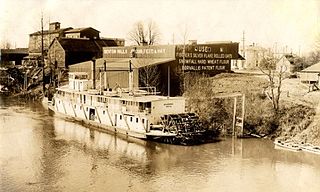
The American Empress is a 360-foot (110 m) diesel-electric powered paddle-wheeler that was formerly operated by Majestic America Line and named the Empress of the North. She was built in 2002 at the Nichols Brothers Boat Builders shipyard on Whidbey Island, in the U.S. state of Washington, for $50 million and debuted as a cruise ship in 2003. She is listed as accommodating 223 guests, and originally cruised Alaska's Inside Passage, the Pacific Northwest, and the Columbia River. While being operated by Majestic America Line, the ship was decorated with a 19th century Russian theme, but with Alaskan touches in the form of carvings and masks.

Many steamboats operated on the Columbia River and its tributaries, in the Pacific Northwest region of North America, from about 1850 to 1981. Major tributaries of the Columbia that formed steamboat routes included the Willamette and Snake rivers. Navigation was impractical between the Snake River and the Canada–US border, due to several rapids, but steamboats also operated along the Wenatchee Reach of the Columbia, in northern Washington, and on the Arrow Lakes of southern British Columbia.

The Willamette River flows northwards down the Willamette Valley until it meets the Columbia River at a point 101 miles from the Pacific Ocean, in the U.S. state of Oregon.

The Bailey Gatzert was a sternwheel steamboat that ran on the Columbia River and Puget Sound from the 1890s to the 1920s. This vessel was considered one of the finest of its time. It was named after Bailey Gatzert, an early businessman and mayor of Seattle, who was one of the closest friends and business associates of John Leary – the person who financed the ship.

The steamship Altona operated from 1890 to 1907 on the Willamette River in the U.S. state of Oregon. In 1907, she was transferred to Alaska.

The steamboat Hassalo operated from 1880 to 1898 on the Columbia River and Puget Sound. Hassalo became famous for running the Cascades of the Columbia on May 26, 1888 at a speed approaching 60 miles (97 km) an hour. This vessel should not be confused with other steamboats with the same or a similar name, including Hassalo (1899) and Hassaloe (1857).

R. R. Thompson was a large sternwheel steamboat designed in the classic Columbia River style. She was named after Robert R. Thompson, one of the shareholders of the Oregon Steam Navigation Company, the firm that built the vessel.

Gazelle was an early sidewheeler on the Willamette River in what is now the U.S. state of Oregon. She did not operate long, suffering a catastrophic boiler explosion on April 8, 1854, less than a month after her trial voyage. This was the worst such explosion ever to occur in the Pacific Northwest states. The wrecked Gazelle was rebuilt and operated for a few years, first briefly as the unpowered barge Sarah Hoyt and then, with boilers installed, as the steamer Señorita. A victim of the explosion was D.P. Fuller, age 28, who is buried in Lone Fir Cemetery in Portland, Oregon.

Portland is a sternwheel steamboat built in 1947 for the Port of Portland, Oregon, in the United States.

Emma Hayward commonly called the Hayward, was a steamboat that served in the Pacific Northwest. This vessel was once one of the finest and fastest steamboats on the Columbia River and Puget Sound. As newer vessels came into service, Emma Hayward was relegated to secondary roles, and, by 1891, was converted into a Columbia river tow boat.

Pomona was a steamboat which operated on the Willamette, Columbia and Cowlitz rivers from 1898 to 1940. Pomona was specially designed to operate in low water conditions such as typically prevailed in the summer months in Oregon. Pomona was one of the few steamers that could regularly navigate to Corvallis, Oregon, which was the practical head of navigation on the Willamette. In 1926, Pomona was substantially rebuilt, and served afterwards as a towboat. In 1940, Pomona was converted into an unpowered floating storehouse.

Grahamona was a sternwheel steamboat built in 1912 for the Oregon City Transportation Company, commonly known as the Yellow Stack Line. Grahamona was specially designed to serve on the shallow waters of the upper Willamette River. It was one of the largest steamboats ever to operate on the upper Willamette. In 1920, Grahamona was sold and the name was changed to Northwestern. In 1939, the vessel was sold again, and transferred to Alaska for service on the Kuskokwim River.

Elwood was a sternwheel steamboat which was built to operate on the Willamette River, in Oregon, but which later operated on the Lewis River in Washington, the Stikine River in Canada, and on Puget Sound. The name of this vessel is sometimes seen spelled "Ellwood". Elwood is probably best known for an incident in 1893, when it was approaching the Madison Street Bridge over the Willamette River in Portland, Oregon. The bridge swung open to allow the steamer to pass. However, a streetcar coming in from the east end of the bridge failed to notice the bridge was open, and ran off into the river in the Madison Street Bridge disaster.

Jennie Clark, also seen spelled Jenny Clark, was the first sternwheel-driven steamboat to operate on the rivers of the Pacific Northwest, including British Columbia. This vessel was commonly known as the Jennie when it was in service. The design of the Jennie Clark set a pattern for all future sternwheel steamboats built in the Pacific Northwest and in British Columbia.

Black Hawk was one of three small iron-propeller driven steamboats manufactured in Philadelphia in about 1850 and shipped to the west coast of United States to be placed in river service. The other boats were Eagle and Major Redding. These boats were some of the earliest steamers to operate on the Willamette and Columbia rivers. They could carry about 12 passengers and perhaps a ton of cargo. The boats had to be small to make the run to Oregon City, which passed through the Clackamas rapids a short distance downriver from the town.

Harvest Queen was the name of two stern-wheel steamboat built and operated in Oregon. Both vessels were well known in their day and had reputations for speed, power, and efficiency.The first Harvest Queen, widely considered one of the finest steamers of its day, was constructed at Celilo, Oregon, which was then separated from the other portions of the navigable Columbia River by two stretches of difficult to pass rapids.

Minnehaha was a sternwheel-driven steamboat which was built in 1866 on Oswego Lake, then known as Sucker Lake, in Oregon, United States. Minnehaha was later transferred to the Willamette and Columbia rivers where it operated for the first part of the 1870s.

Telephone was a sternwheel-driven steamboat built in 1884 by Captain Uriah Bonsor "U.B." Scott for service on the Columbia River. Reputedly the fastest steamboat in the world in its time, Telephone served on the Columbia River and San Francisco Bay. Telephone was rebuilt at least twice. The first time was after a fire in 1887 which nearly destroyed the vessel. The reconstructed and much larger second vessel was sometimes referred to as Telephone No. 2. The third vessel, Telephone No. 3, built in 1903 and using components from the second steamer was larger but little used during its time on the Columbia river.

Orient was a light-draft sternwheel-driven steamboat built in 1875 for the Willamette River Transportation Company, a concern owned by pioneer businessman Ben Holladay. Shortly after its completion, it was acquired by the Oregon Steam Navigation Company. Orient was a near-twin vessel of a steamer built at the same time, the Occident.

Relief was a stern-wheel steamboat that operated on the Columbia and Willamette rivers and their tributaries from 1906 to 1931. Relief had been originally built in 1902, on the Columbia at Blalock, Oregon, in Gilliam County, and launched and operated as Columbia, a much smaller vessel. Relief was used primarily as a freight carrier, first for about ten years in the Inland Empire region of Oregon and Washington, hauling wheat and fruit, and after that was operated on the lower Columbia river.
























